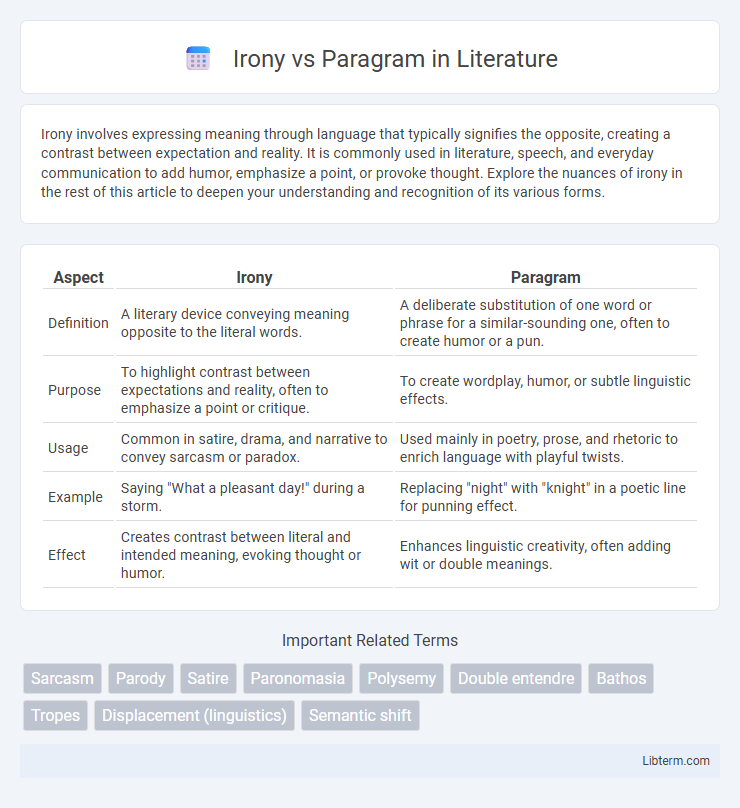Irony involves expressing meaning through language that typically signifies the opposite, creating a contrast between expectation and reality. It is commonly used in literature, speech, and everyday communication to add humor, emphasize a point, or provoke thought. Explore the nuances of irony in the rest of this article to deepen your understanding and recognition of its various forms.
Table of Comparison
| Aspect | Irony | Paragram |
|---|---|---|
| Definition | A literary device conveying meaning opposite to the literal words. | A deliberate substitution of one word or phrase for a similar-sounding one, often to create humor or a pun. |
| Purpose | To highlight contrast between expectations and reality, often to emphasize a point or critique. | To create wordplay, humor, or subtle linguistic effects. |
| Usage | Common in satire, drama, and narrative to convey sarcasm or paradox. | Used mainly in poetry, prose, and rhetoric to enrich language with playful twists. |
| Example | Saying "What a pleasant day!" during a storm. | Replacing "night" with "knight" in a poetic line for punning effect. |
| Effect | Creates contrast between literal and intended meaning, evoking thought or humor. | Enhances linguistic creativity, often adding wit or double meanings. |
Understanding Irony: Definition and Types
Irony is a rhetorical device where the intended meaning is opposite to the literal meaning, often used to convey humor or emphasize a point. Common types include verbal irony, where what is said contrasts with what is meant; situational irony, involving a discrepancy between expected and actual outcomes; and dramatic irony, where the audience knows information that characters do not. Understanding these types enhances comprehension of nuanced communication and literary techniques.
Exploring Paragram: Definition and Uses
Paragram refers to a deliberate play on words involving a substitution or alteration of letters to create a humorous or witty effect, often used in literature and rhetoric to enhance meaning or irony. It contrasts with irony by focusing on phonetic or grammatical shifts rather than situational or verbal contradictions. Writers and speakers employ paragram to engage readers through clever wordplay, enriching narratives and emphasizing particular themes or emotions.
Key Differences Between Irony and Paragram
Irony involves expressing meaning by using language that signifies the opposite, often to highlight contrast or sarcasm, while paragram is a linguistic device that alters words intentionally to create humor or a pun through slight misspelling or altered pronunciation. Irony relies on contextual understanding and tone to convey its contradictory message, whereas paragram depends on wordplay and phonetic similarity for effect. Key differences include irony's broader use in sarcasm and wit versus paragram's specific function in punning and playful textual distortions.
Historical Origins of Irony and Paragram
Irony traces its origins to ancient Greek literature, particularly in the works of Socratic dialogues where it denoted a form of feigned ignorance to provoke insight. Paragram, rooted in classical rhetoric, refers to a play on words or deliberate misuse, evolving notably during the Renaissance as a literary device for wit and humor. Both devices illustrate the historical intertwining of language, thought, and stylistic creativity in Western literature.
Literary Examples of Irony
Irony, a literary device exemplified by Shakespeare's *Romeo and Juliet*, often presents situations where the outcome contrasts sharply with expectations, such as the tragic misunderstanding leading to the lovers' deaths. Paragram, by contrast, involves deliberate wordplay or mispronunciation for humor or emphasis, evident in works like Lewis Carroll's *Jabberwocky* with playful linguistic twists. In literary analysis, irony deepens thematic complexity and emotional impact, while paragram highlights creativity in language use.
Literary Examples of Paragram
Paragram refers to a deliberate play on words where a slight change in spelling or sound alters meaning, often used in puns and wordplay to create humor or irony. Literary examples of paragram include Shakespeare's use of wordplay in "Romeo and Juliet," where Mercutio's punning on "grave" serves as a paragram that deepens the scene's tragic irony. Another instance is Lewis Carroll's "Through the Looking-Glass," where the manipulation of words exemplifies paragrammatic wit to challenge logic and meaning.
The Role of Context in Irony and Paragram
The role of context in irony is crucial as it relies on an incongruity between literal meaning and intended meaning, often requiring shared knowledge or situational cues to decode the speaker's true intent. In paragram, context guides the recognition of lexical or phonological play that subverts expected language norms, creating humor or critique through deliberate word substitutions. Both linguistic phenomena depend on pragmatic context, but irony hinges on contrasting meanings while paragram emphasizes form and sound manipulation within language.
Effects on Reader Interpretation
Irony creates a contrast between expectation and reality, prompting readers to question underlying meanings and engage in deeper interpretation. Paragram, through purposeful wordplay and slight alterations in language, encourages readers to recognize subtle nuances and reinterpret phrases creatively. Both literary devices enhance textual complexity, influencing reader perception by challenging straightforward comprehension.
Irony vs Paragram in Modern Writing
Irony in modern writing often employs subtle contrasts between expected and actual meanings to create humor or emphasize a point, enhancing narrative depth and reader engagement. Paragram, a less common rhetorical device, involves playful word substitutions or malapropisms, adding layers of wit and linguistic creativity. The nuanced use of irony typically serves broader thematic purposes, while paragram emphasizes linguistic playfulness, making both essential tools for stylistic variation in contemporary literature.
Choosing Between Irony and Paragram: Best Practices
Choosing between irony and paragram depends on context and communicative intent, with irony relying on contrast between literal and intended meaning, while paragram emphasizes playful word substitution or punning. Best practices include assessing audience familiarity and sensitivity to ensure clarity in irony, and leveraging paragram's linguistic creativity to enhance humor or rhetorical effect without causing confusion. Effective use balances tone, purpose, and the semantic layers of language to maximize engagement and comprehension.
Irony Infographic

 libterm.com
libterm.com